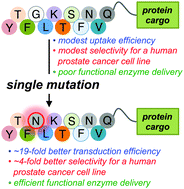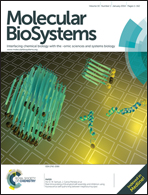Mutagenesis modulates the uptake efficiency, cell-selectivity, and functional enzyme delivery of a protein transduction domain†
Abstract
Alanine scanning mutagenesis of a recently reported prostate cancer cell-selective Protein Transduction Domain (PTD) was used to assess the specific contribution each residue plays in cell uptake efficiency and cell-selectivity. These studies resulted in the identification of two key residues. Extensive mutagenesis at these key residues generated multiple mutants with significantly improved uptake efficiency and cell-selectivity profiles for targeted cells. The best mutant exhibits ∼19-fold better uptake efficiency and ∼4-fold improved cell-selectivity for a human prostate cancer cell line. In addition, while the native PTD sequence was capable of delivering functional fluorescent protein to the interior of a prostate cancer cells, only modest functional enzyme delivery was achieved. In contrast, the most potent mutant was able to deliver large quantities of a functional enzyme to the interior of human prostate cancer cells. Taken together, the research described herein has significantly improved the efficiency, cell-selectivity, and functional utility of a prostate cancer PTD.


 Please wait while we load your content...
Please wait while we load your content...